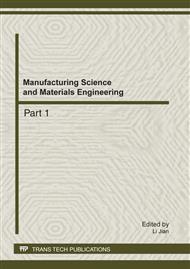[1]
Seo, J., Venugopal, R., and Kenne, J. -P, Feedback linearization based control of a rotational hydraulic drive, Control Engineering Practice, vol. 15, 2007, p.1495–1507.
DOI: 10.1016/j.conengprac.2007.02.009
Google Scholar
[2]
Vossoughi, G. and Donath, M, Dynamic feedback linearization for electro- hydraulically actuated systems, ASME Journal of Dynamic Systems, Measurement, and Control, vol. 117, 1995, p.468–477.
DOI: 10.1115/1.2801102
Google Scholar
[3]
Guan, C. and Pan, S., Adaptive sliding mode control of electro-hydraulic system with nonlinear unknown parameters, Control Engineering Practice, vol. 16, 2008, p.1275–1284.
DOI: 10.1016/j.conengprac.2008.02.002
Google Scholar
[4]
Plummer, A.R., &Vaughan, N.D., Robust adaptive control for hydraulic servo systems, ASME Journal of Dynamic Systems, Measurement, and Control, vol. 118, 1996, p.237–244.
DOI: 10.1115/1.2802309
Google Scholar
[5]
Sekhavat, P., Sepehri,N., &Wu,Q., Impact stabilizing controller for hydraulic actuators with friction: Theory and experiments, Control Engineering Practice, vol. 14, 2006, p.1423–1433.
DOI: 10.1016/j.conengprac.2005.10.007
Google Scholar
[6]
Mare, J. -C., Dynamic loading systems for ground testing of high speed aerospace actuators, Aircraft Engineering and Aerospace Technology: An Inter national Journal, 78(4), 2006, p.275–282.
DOI: 10.1108/17488840610675546
Google Scholar
[7]
Jacazio, G., &Balossini,G., Real-time loading actuator control for an advanced aerospace testrig, Proceedings of the Institution of Mechanical Engineers PartI, Journal of Systems and Control Engineering, vol. 221, 2007, p.199–210.
DOI: 10.1243/09596518jsce269
Google Scholar
[8]
Plummer, A.R., Robust electro hydraulic force control, Proceedings of the Institution of Mechanical Engineers PartI:, Journal of Systems and Control Engineering, vol. 221, 2007, p.717–731.
DOI: 10.1243/09596518jsce370
Google Scholar
[9]
Mark Karpenko a, 1, Nariman Sepehri, On quantitative feedback design for robust position control of hydraulic actuators, Control Engineering Practice, vol. 18, 2010, p.289–299.
DOI: 10.1016/j.conengprac.2009.11.007
Google Scholar
[10]
Sang Yeal Lee, Hyung Suck Cho, A fuzzy controller for an electro-hydraulic fin actuator using phase plane method, Control Engineering Practice vol. 11, 2003 , p.697–708.
DOI: 10.1016/s0967-0661(02)00179-x
Google Scholar
[11]
Berger, M., Self-tuning of a PI controller using fuzzy logic, for a construction unit testing apparatus, Control Engineering Practice, 4(6), 1996, p.785–790.
DOI: 10.1016/0967-0661(96)00069-x
Google Scholar
[12]
Kim, S. -M., & Han, W. -Y., Induction motor servo drive using robust PID-like neuro-fuzzy controller. Control Engineering Practice, 14(5), 2006, p.481–487.
DOI: 10.1016/j.conengprac.2005.03.002
Google Scholar
[13]
Yan Jie, and Pan Hongliang, Effects of supply pressures on two-stage electro-hydraulic servo valve, submitted to CCCM (2010).
Google Scholar
[14]
Merritt, H. E. Hydraulic control systems. 1976, New York: Wiley. Figure 4. Block diagram of the control loop Figure 5. Fuel flow rate vs. position of the cylinder (left) & vs. pump shaft speed (right) Figure6. History of the piston position at different working conditions.
Google Scholar


